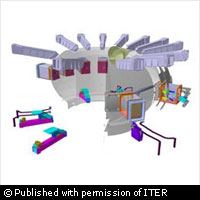Europe builds a sustainable future with fusion
ITER, a joint international research project, will attempt to reproduce on Earth the nuclear reactions that power the Sun and other stars. To test whether this is possible, plasma turbulence simulation and modelling tools are being developed, but these require a huge amount of computing power to process data. This is where EUFORIA, a €3.65 million EU-funded project, comes in. It aims to link computers from all over Europe and harmonise the simulations made in various areas of fusion. Bringing together partners from France, Finland, Germany, Italy Spain, Poland, Slovenia, Sweden and UK, the project will work between now and 2010 to distribute the computing capacity needed for simulating ITER to networks of computers and high performance computers (HPC) across Europe. 'We try to link the different computer architectures such that the strengths of the respective architecture are made use of to the full extent,' stresses Dr Marcus Hardt, EUFORIA project coordinator at the Karlsruhe Research Centre (FZK) in Germany. Until now, simulation programs from various fields of physics have been conducted separately. These individual simulation program frequently involves extensive calculation processes, taking months before results are available. The EUFORIA project hopes to bring these programs together to simulate the fusion reactor as a whole. Initially, the project will focus on adapting and optimising plasma physics and magnetic confinement fusion codes for use in grid and HPC environments. The aim is to make the programs containing the code run faster and to enable them to use a larger number of processors in order to solve substantially larger problem instances. The lessons learned during this development phase will be made publicly available and direct support will be provided to new users who wish to integrate their fusion codes into the EUFORIA platform. This activity alone will provide a significant step forward in the modelling capacities and capabilities of the fusion modelling community, say the project partners. The coupling of different computational modules and codes requires a large degree of coordination and structured data management and efficient resource scheduling. In its second phase, the project will develop a workflow orchestration tool to facilitate the integration process and provide a structure or framework for performing additional tasks such as computational steering and interactive monitoring or control. The end result, the project partners hope, is improved integrated modelling capabilities of fusion plasmas, as well as new fusion computing infrastructure and tools.



